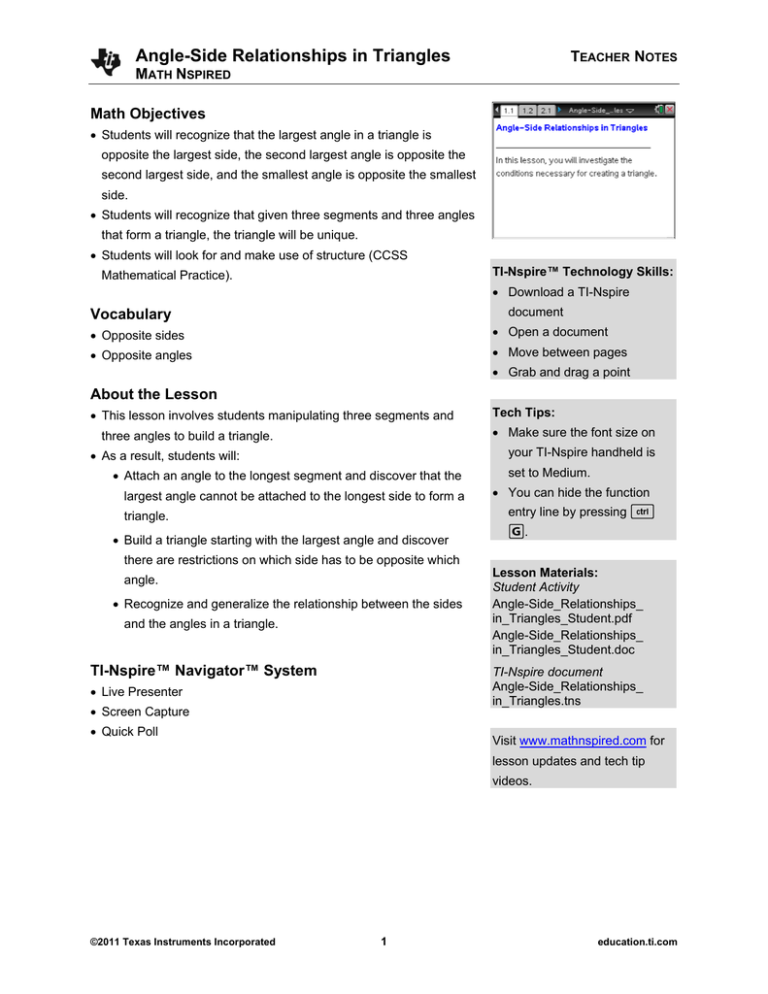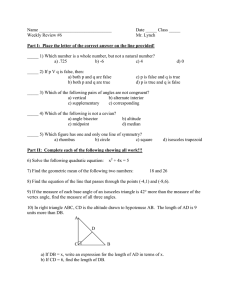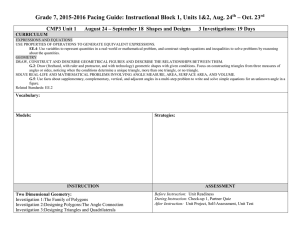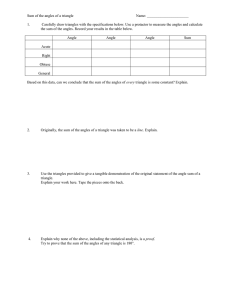Teacher Notes PDF - Texas Instruments
advertisement

Angle-Side Relationships in Triangles TEACHER NOTES MATH NSPIRED Math Objectives • Students will recognize that the largest angle in a triangle is opposite the largest side, the second largest angle is opposite the second largest side, and the smallest angle is opposite the smallest side. • Students will recognize that given three segments and three angles that form a triangle, the triangle will be unique. • Students will look for and make use of structure (CCSS TI-Nspire™ Technology Skills: Mathematical Practice). • Download a TI-Nspire document Vocabulary • Opposite sides • Open a document • Opposite angles • Move between pages • Grab and drag a point About the Lesson • This lesson involves students manipulating three segments and Tech Tips: • Make sure the font size on three angles to build a triangle. your TI-Nspire handheld is • As a result, students will: • Attach an angle to the longest segment and discover that the largest angle cannot be attached to the longest side to form a triangle. • Build a triangle starting with the largest angle and discover set to Medium. • You can hide the function entry line by pressing / G. there are restrictions on which side has to be opposite which angle. • Recognize and generalize the relationship between the sides and the angles in a triangle. TI-Nspire™ Navigator™ System Lesson Materials: Student Activity Angle-Side_Relationships_ in_Triangles_Student.pdf Angle-Side_Relationships_ in_Triangles_Student.doc TI-Nspire document Angle-Side_Relationships_ in_Triangles.tns • Live Presenter • Screen Capture • Quick Poll Visit www.mathnspired.com for lesson updates and tech tip videos. ©2011 Texas Instruments Incorporated 1 education.ti.com Angle-Side Relationships in Triangles TEACHER NOTES MATH NSPIRED Discussion Points and Possible Answers Teacher Tip: Working with the .tns file may go more smoothly if you demonstrate for the whole class how to put the sides and angles together and take them apart. Teacher Tip: You may wish to assign groups to work on the parts of question 3a, with each group attaching a different angle to the longest segment. Afterwards, discuss question 3b as a class. Tech Tip: To move a segment or angle, grab the open circle. To rotate a segment or angle, grab the closed circle. Students might find it easier to place the open end at the vertex where they want the segment and then rotate the segment using the closed end. When a segment is attached to a vertex, the vertex point will become a larger dark circle. To attach an angle to a segment, be sure students overlay the vertex of the angle on the open circle endpoint of the segment. Using the closed circle on the angle, the angle can be rotated to align a side of the angle with the segment. Move to page 1.2. 1. You have three angles and three segments. Move the angles and segments by grabbing the open and closed circles on each. a. What does the open circle do? Answer: It moves (translates) the segments and angles around. b. What does the closed circle do? Answer: It rotates the segments and angles around the point indicated by the closed circle. ©2011 Texas Instruments Incorporated 2 education.ti.com Angle-Side Relationships in Triangles TEACHER NOTES MATH NSPIRED 2. Connect two of the segments by dragging the open circle of one segment to the open circle of the second segment. Move the vertex of the angle to the intersection of the segments. Rotate the angle and segments to align the segments with the sides of the angle. Describe how you did this. Sample Answer: I rotated the angle to align with one of the segments and then rotated the second segment to align with the other side of the angle. or I rotated both segments to align with the sides of the angle. Teacher Tip: Manipulating the objects is critical to forming triangles. Be sure students are overlaying segment endpoints and angle vertices. Demonstrate for the whole class how to put the objects together and take them apart. Suggest that students “tap” the arrow keys on the NavPad to make fine adjustments to the location of segments and angles. If you grab the middle of a segment, it does not move. Be sure students understand that the size of the angle and the lengths of the segments remain constant regardless of their orientation or location. TI-Nspire Navigator Opportunity: Live Presenter See Note 1 at the end of this lesson. 3. Separate the angles and segments. Your task is to build a triangle. Start by attaching one of the angles to the longest segment. a. Were you able to form a triangle? Record your results in the table below and include a sketch with labels. Answer: See table below. ∠ 1 attached to longest segment Yes, if ∠ 1 is included between segments a and b. No, if ∠ 1 is included between segments a and c. ∠ 2 attached to longest segment Yes, if ∠ 2 is included between segments a and c. No, if ∠ 2 is included between segments a and b. ∠ 3 attached to longest segment No, if ∠ 3 is included between segments a and c. No, if ∠ 3 is included between segments a and b. NOT POSSIBLE TI-Nspire Navigator Opportunity: Screen Capture See Note 2 at the end of this lesson. ©2011 Texas Instruments Incorporated 3 education.ti.com Angle-Side Relationships in Triangles TEACHER NOTES MATH NSPIRED b. What conjectures can you make about creating a triangle starting with the longest segment and an angle? Discuss your results with another student. Answer: Students may or may not have been successful with angles 1 and 2. However, no student should have been successful using ∠ 3. It is possible to form triangles with the two smaller angles attached to the longest side, if the relationship between the sides and angles is in the right order. (See the first two columns in the table above.) It is never possible to form a triangle with the largest angle attached to the longest side. Teacher Tip: This would be a good discussion point, where students articulate their conjectures and reasoning before they continue with the activity. The conjectures might be posted on the board and revisited at the end of the activity. As an option, assign the 3 conditions above to different groups of students and discuss the results as a class before proceeding. 4. Separate the angles and segments. Then use all of the angles and segments to form a triangle, starting with the largest angle, ∠ 3. a. Describe what you did to form the triangle. Answer: Students will start with ∠ 3 and attach either segment b or c to the vertex. From Question 2, they should know they cannot attach segment a, the longest side, to ∠ 3 and be successful. At this point, answers will vary. For example, students could attach an angle to the segment endpoint, then align a second segment to that angle, and finally move the third segment to try to enclose the triangle. This may or may not be successful. If it is not, students will have to switch the two smaller angles to enclose the triangle. b. Does it make a difference where the longest side is located in the triangle? Explain your thinking. Answer: Side b, the longest side, must be opposite ∠ 3, the largest angle. This makes sense because the largest angle needs the most length to connect the sides of the angle. ©2011 Texas Instruments Incorporated 4 education.ti.com Angle-Side Relationships in Triangles TEACHER NOTES MATH NSPIRED 5. Separate the angles and segments. a. Predict a triangle you could build using all six pieces. Make a sketch and label the pieces of the triangle. Answer: Answers may vary. b. Make a conjecture about the location of the smallest angle in the triangle. Explain your reasoning. Answer: The correct conjecture is that the smallest angle must be opposite the shortest side. Reasons might include the smallest angle needs the least length to connect its sides. c. Use all of the pieces to form a triangle, starting with the smallest angle. Does your conjecture hold? Why or why not? Answer: Students should notice that the smallest angle is opposite the shortest side. Move to page 2.1. 6. Use all six pieces. a. Predict a triangle you could build. Make a sketch and label the pieces of the triangle. Answer: Sketches will vary. However, every correct triangle sketch will be a rotation of the same triangle. b. Describe how to build your triangle. Answer: Students may attach all three segments and then fit the angles into the enclosed triangle. They may start with an angle and two sides, fitting the rest of the parts afterward. Regardless of the order of construction, all students should describe how the largest angle must be opposite the longest side, the smallest angle opposite the shortest side, and so on. ©2011 Texas Instruments Incorporated 5 education.ti.com Angle-Side Relationships in Triangles TEACHER NOTES MATH NSPIRED c. Build your triangle using the given angles and segments. How does it match the triangle you sketched in question 5a? Answer: If students sketched the triangle correctly, it should match any other sketch of the triangle with respect to the relationship between the sides and angles, but the orientation on the screen might be different. Teacher Tip: Students might look at the triangles others built and decide whether they have congruent or different triangles. Not recognizing congruent triangles because of different orientations is a misconception some students have, and this provides an opportunity to confront that misconception and discuss it. 7. In UABC, ∠ B is 80°, ∠ C is 55°, and A C is 10 centimeters. Which of the following are possible choices for the missing side lengths? Explain your thinking for each of the choices. a. BC = 12 cm, AB = 2cm Answer: Not possible because A C has to be the longest side since it is opposite the largest angle. b. BC = 6 cm, AB = 4 cm Answer: Not possible because B C has to be the shortest side since it is opposite the smallest angle. c. BC = 7 cm, AB = 8 cm Answer: Possible because the missing angle, ∠ A, is 45° degrees. B C is the shortest side and is opposite ∠ A, the smallest angle. Teacher Tip: Remind students that the angles in a triangle sum to 180°. TI-Nspire Navigator Opportunity: Quick Poll See Note 3 at the end of this lesson. ©2011 Texas Instruments Incorporated 6 education.ti.com Angle-Side Relationships in Triangles TEACHER NOTES MATH NSPIRED 8. In UDEF, D E is 12 inches, D F is 5 inches, and E F is 13 inches. Angle F is 67°. Which of the following could be the measure of ∠ E? Explain your reasoning. 23° 80° 90° 120° Answer: 23° could be the measure because ∠ E is opposite DF , the shortest side. Therefore, the measure of ∠ E must be less than 67°. The only possible choice is 23°. 9. In the diagram, which segment is the longest? Explain how you know. Answer: DC ; the measure of ∠ A is 63°, the largest angle in ∆ABD. Therefore, DB is the longest segment in ∆ABD. The measure of ∠ DBC is 62°, making it the largest angle in ∆BCD. Therefore, DC is the longest segment, longer than D B , which is the shortest side of ∆BCD. 10. If you are given three segments and three angles that form a triangle, how many possible triangles can you form? Justify your answer. Answer: You can form one unique triangle, where the longest side is opposite the largest angle and the shortest side is opposite the smallest angle, leaving the third side opposite the third angle. This is the only combination that yields a triangle using all 6 parts. Teacher Tip: Students may say that more than 1 triangle is possible because of the orientation of the triangles on the screen. Help them understand that although their triangle may be rotated differently from another student’s, the triangles are congruent. ©2011 Texas Instruments Incorporated 7 education.ti.com Angle-Side Relationships in Triangles TEACHER NOTES MATH NSPIRED Wrap Up Upon completion of the discussion, the teacher should ensure that students understand: • The largest angle in a triangle is opposite the longest side, the second largest angle is opposite the second longest side, and the smallest angle is opposite the shortest side. • If a triangle is formed from 3 given sides and 3 given angles, then that triangle will be unique (that is, any 2 triangles formed from the given parts will be congruent). Assessment: • Put the given side lengths in the appropriate place in the triangle: 8 ft, 13 ft, 18 ft. 116° 41° • Put the given angle measures in the appropriate place in the triangle: 38º, 94º. 16 12 10 TI-Nspire NavigatorTM System Note 1 Question 2, Live Presenter Use Teacher Edition computer software or Live Presenter to show students how to move the segments and angles. This will ensure that students are successful creating a triangle in question 3a. Note 2 Question 3a, Screen Capture Use Screen Capture to view each student’s triangle that they have created. Discuss how the triangles are similar and different. This will help them form a conjecture in question 3b. Note 3 Question 7, Quick Poll Use a 2-choice Quick Poll to assess whether students’ think the lengths given are possible. Then, as a class, discuss how they came to that conclusion. For example, send the following question to students: 7. a. Are BC = 12 cm and AB = 2 cm possible choices for the missing side lengths? A. yes B. no ©2011 Texas Instruments Incorporated 8 education.ti.com



